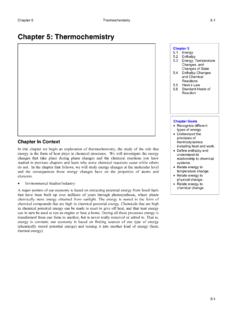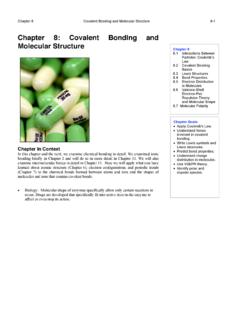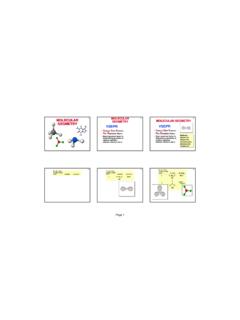Transcription of Chapter 7 Electron Configurations and the …
1 Chapter 7 Electronic Configurations and the properties of Atoms 1 Chapter 7 Electron Configurations and the properties of Atoms In this In the last Chapter we introduced and explored the concept of orbitals, which define the shapes electrons take around the nucleus of an atom. In this Chapter we expand this description to atoms that contain more than one Electron and compare atoms that differ in their numbers of protons in the nucleus and electrons surrounding that nucleus. Much of what we know and can predict about the properties of an atom can be derived from the number and arrangement of its electrons and the energies of its orbitals, including its size, and the types and number of bonds it will form, among many other properties .
2 Chapter Outline Electron Spin and Magnetism Orbital Energy Electron configuration of Elements properties of Atoms Formation and Electron configuration of Ions Chapter Summary Chapter Summary Assignment Electron Spin and Magnetism Section Outline Electron Spin and the Spin Quantum Number, ms Types of Magnetic Materials Section Summary Assignment In this section, we introduce the concept of Electron spin and the spin quantum number, ms. The idea of Electron spin was first proposed in the 1920s and was supported by experiments that further supported the quantum theory of the atom described in the previous Chapter . Opening Exploration Types of Magnets Chapter 7 Electronic Configurations and the properties of Atoms - 2 - Electron Spin and the Spin Quantum Number, ms Although electrons are too small to observe directly, we can detect the magnetic field that they exert.
3 This magnetic field is generated by Electron spin, the negatively charged Electron spinning on an axis (Interactive Figure ). Interactive Figure : Relate Electron spin and magnetic properties . Electron spin and magnetic field The magnetic field produced by an Electron occurs in one of two directions, indicating that Electron spin is quantized. That is, an Electron has only two possible spin states. In one spin state, the Electron produces a magnetic field with the North pole in one direction. In the other spin state, the North pole is in the opposite direction (Figure ). Figure Electron spin and magnetic fields. Spin states are defined by a fourth quantum number, the spin quantum number, ms.
4 Because there are two different spin states, ms has two possible values: + or . The sign of ms is used to indicate the fact that the two spin states are in opposite directions and should not be confused with the negative charge on the Electron . Symbolizing Electron Spin We saw in the previous Chapter that lines or boxes can be used to depict orbitals. Electrons in orbitals are shown using arrows, where the direction of the arrow indicates the spin state of the Electron . For example, in the diagram that follows, the upward ( ) and downward ( ) arrows indicate electrons in different spin states. Chapter 7 Electronic Configurations and the properties of Atoms - 3 - In this text, we will arbitrarily assign ms = + to electrons represented with an upward arrow (also called spin up electrons) and ms = to electrons represented with a downward arrow (also called spin down electrons).
5 Types of Magnetic Materials Magnetic materials derive their magnetic behavior from the magnetic properties of their electrons. Because all electrons produce a magnetic field, you might ask the question, Why aren t all materials magnetic? The answer lies in the fact that the magnetic fields generated by electrons with opposite spin (in a single atom, molecule, or ion) directly counteract and cancel each other. Therefore, any atom or molecule with half spin up electrons and half spin down electrons will have a net magnetic field of zero. Two electrons with opposite spin are said to be spin paired and produce no net magnetic field. An uneven number of electrons leaves unpaired electrons. Materials with unpaired electrons are magnetic.
6 The magnetism of most materials can be categorized as being diamagnetic, paramagnetic, or ferromagnetic. In a diamagnetic material (Interactive Figure (a)), all electrons are spin paired and the material does not have a net magnetic field. These materials are slightly repelled by the magnetic field of a strong magnet. Interactive Figure : Use spin states to predict magnetic properties . Electron spin representations of a material with (a) diamagnetic, (b) paramagnetic, and (c) ferromagnetic properties . Paramagnetic materials (Interactive Figure (b)) contain atoms, molecules, or ions with unpaired electrons. In the absence of an external, strong magnetic field, the magnetic fields generated by the individual particles are arranged in random directions and the magnetism produced by each atom or molecule can be cancelled by the magnetic fields around it.
7 This results in a magnetic material, but one with a weak net magnetic field. However, the presence of strong, external magnet causes the individual spins to align so that the material is attracted to the magnet. Ferromagnetic materials (Interactive Figure (c)), like paramagnetic materials, contain particles with unpaired electrons. In these materials, however, the individual magnetic fields align naturally and produce a strong, permanent magnetic field. The common magnets you are familiar with are ferromagnets. Chapter 7 Electronic Configurations and the properties of Atoms - 4 - Orbital Energy Section Outline Orbital Energies in Single- and Multielectron Species Section Summary Assignment In the previous Chapter , we observed that the energy of an orbital in a hydrogen atom is related to its size: the larger the orbital, the higher the energy of an Electron in that orbital.
8 The size of the orbital was also shown to be dependent on the principal quantum number, n. In this section, we explore the energy of orbitals in single- and multielectron atoms. Opening Exploration Orbital Energies in Single and Multielectron Species The relationship between the principal quantum number, n, and orbital energy is shown in an orbital energy diagram (Figure ). Figure Identify Orbital Energies in Single- Electron Species Orbital energies (n = 1 to n = 4) in a single Electron species For a single- Electron species such as a hydrogen atom, the energy of the atomic orbitals depends only on the value of n. For example, a 2p orbital in a hydrogen atom has the same energy as a 2s orbital.
9 The energy of an orbital in a single- Electron system depends only on the degree of attraction Chapter 7 Electronic Configurations and the properties of Atoms - 5 - between the Electron in that orbital and the nucleus. This is mainly a function of the average distance of the Electron from the nucleus, which is controlled by the principal quantum number, n. In multielectron species such as helium atoms or sodium ions, the orbital energies depend both on the principal quantum number, n, and the type of orbital, given by the angular momentum quantum number, (Interactive Figure ). Multielectron atoms are more complex because the energy of the Electron depends on both how close an Electron is to the nucleus and the degree to which it experiences repulsive forces with the other electrons present in the atom or ion.
10 Interactive Figure : Identify orbital energies in multi- Electron species. Orbital energies in a multielectron species As shown in Interactive Figure , subshell energies increase with increasing (in a given energy level, s < p < d < f). Using Interactive Figure as a reference, we can make several generalizations about orbital energies in multielectron species. As n increases, orbital energy increases for orbitals of the same type. A 4s orbital is higher in energy than a 3s orbital. As increases, orbital energy increases. In the n = 3 shell, 3s < 3p < 3d. As n increases, the subshell energies become more closely spaced and overlapping occurs. The 4f orbital is higher in energy than the 5s orbital, despite its lower n value.















